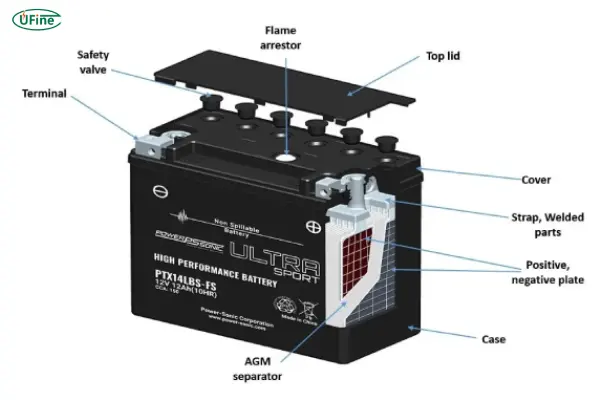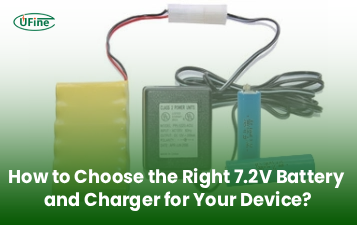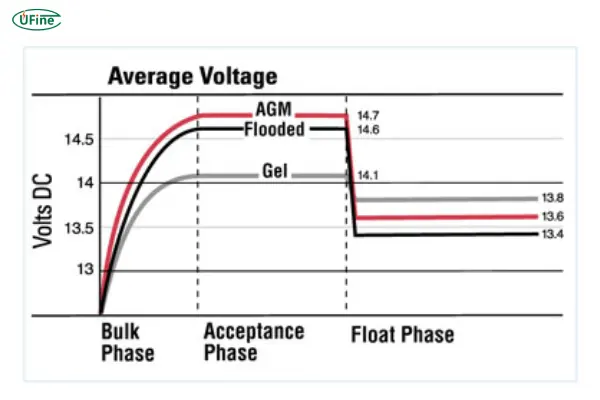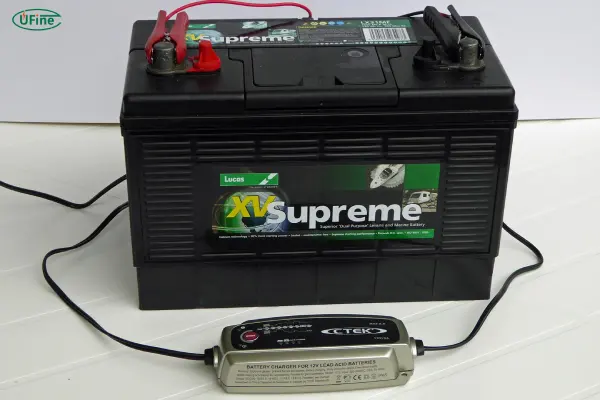
- Part 1. What is an absorbed glass mat battery?
- Part 2. How absorbed glass mat batteries work
- Part 3. Charging and discharge basics
- Part 4. AGM battery charging voltage & settings
- Part 5. Step-by-step AGM battery charging guide
- Part 6. AGM vs. other battery types: charging differences
- Part 7. Common AGM charging mistakes to avoid
- Part 8. Best chargers for AGM batteries
- Part 9. AGM batteries for longevity
- Part 10. Troubleshooting AGM charging issues
- Part 11. Final thoughts
- Part 12. FAQs
Part 1. What is an absorbed glass mat battery?
An Absorbed Glass Mat (AGM) battery is a type of lead-acid battery. But unlike traditional flooded batteries, AGM batteries use a special glass mat separator to hold the electrolyte in place. This design makes them spill-proof, maintenance-free, and highly resistant to vibration.

AGM batteries are popular in cars, motorcycles, RVs, boats, and backup power systems. They’re also widely used in solar setups and off-grid energy storage. Because of their advanced design, AGM battery charging needs a bit more care than regular batteries.
AGM VS Lithium VS Lead-Acid Battery: Comprehensive Comparison
Part 2. How absorbed glass mat batteries work
Inside an AGM battery, lead plates are surrounded by fiberglass mats. These mats are soaked in electrolyte, but there’s no free liquid sloshing around. The mats keep everything stable and improve the battery’s performance.
During charging and discharging, a chemical reaction happens between the lead plates and the electrolyte. This process stores and releases energy. The mat keeps the reaction balanced and ensures faster energy flow, longer life, and better performance—if the battery is charged properly.
Part 3. Charging and discharge basics
Like all batteries, an AGM battery charges by applying a voltage higher than its current state. During discharging, the battery delivers power to devices or systems. The key is charging it correctly to avoid overcharging or undercharging, both of which can damage the battery.
Most AGM batteries operate at 12V, but you can find 6V and 24V models too. The charge voltage for AGM batteries is typically between 14.4V and 14.7V, depending on the battery and charger.
Part 4. AGM battery charging voltage & settings
When charging an absorbed glass mat battery, voltage and settings matter a lot. Here are the key numbers to remember:
- Bulk charge voltage: 14.4V to 14.7V
- Float charge voltage: 13.2V to 13.8V
- Temperature compensation: Reduce voltage slightly in hot temperatures and raise it in cold conditions.
Most smart chargers will detect these levels automatically. However, if you’re using a manual charger, you must set the correct voltage for AGM battery charging. Using the wrong voltage can shorten battery life or even cause failure.
Part 5. Step-by-step AGM battery charging guide
Here’s how to safely and effectively charge your AGM battery:
- Check the battery label – Look for recommended charging voltages.
- Choose the right charger – Make sure it’s compatible with AGM batteries.
- Turn off connected devices – Disconnect any load from the battery.
- Connect the charger – Positive to positive, negative to negative.
- Set the correct voltage – If using a manual charger, input the proper AGM charging voltage.
- Start charging – Most chargers will go through bulk, absorption, and float stages automatically.
- Monitor the process – Watch for signs of overheating or strange smells.
- Finish and disconnect – Once fully charged, unplug the charger and reconnect the battery to your device or system.
Simple, right? But using the wrong charger or skipping a step can cause problems.
Part 6. AGM vs. other battery types: charging differences
AGM batteries may be similar to flooded lead-acid or gel batteries, but they have unique needs:
- Flooded batteries need water topping and vent during charge. AGM batteries don’t.
- Gel batteries require even lower charging voltage than AGMs.
- Lithium-ion batteries use completely different charging methods and voltage levels.
If you try to charge an AGM battery like a regular flooded battery, you might overcharge it. And charging it like a gel battery could lead to undercharging. So always treat absorbed glass mat battery charging as a unique process.
Part 7. Common AGM charging mistakes to avoid
Let’s face it. Many users damage their batteries because of simple mistakes. Here are the most common ones:
- Overcharging – This creates heat and gases that damage the battery.
- Undercharging – Sulfation builds up on the plates, reducing capacity.
- Using a flooded battery charger – Wrong charging profile = short battery life.
- Not using temperature compensation – Especially in extreme weather.
- Charging a deeply discharged battery too fast – Can cause internal heat damage.
Avoid these mistakes and your AGM battery will thank you with longer life and better performance.
Part 8. Best chargers for AGM batteries
When choosing a charger for AGM battery charging, look for these features:
- AGM-compatible mode
- Multi-stage charging (bulk, absorption, float)
- Automatic voltage detection
- Temperature compensation
- Safety features like short-circuit protection and reverse polarity
Top recommended brands include NOCO Genius, CTEK, Schumacher, and Battery Tender. A good charger will protect your investment and extend battery life.
Part 9. AGM batteries for longevity
Charging plays a huge role in how long your absorbed glass mat battery lasts. But that’s not the only factor.
Here’s how to get the most out of your battery:
- Charge it before it drops below 50%.
- Use a smart charger with float mode.
- Store it fully charged during off-season.
- Avoid heat exposure.
- Clean the terminals regularly.
With the right charging habits, an AGM battery can last 5–7 years or more.
Part 10. Troubleshooting AGM charging issues
Having trouble with your battery not charging? Here’s a checklist:
- Battery won’t charge? Check the charger output. It might not be compatible with AGM.
- Slow charging? You may be using the wrong voltage setting.
- Charger keeps shutting off? Could be a battery issue or auto-shutoff in the charger.
- Overheating battery? Disconnect immediately and check the voltage.
- Battery drains fast? Likely sulfation due to repeated undercharging.
If your battery is more than 5 years old, it may simply be time for a replacement.
Part 11. Final thoughts
Absorbed glass mat battery charging isn’t hard, but it requires attention to detail. With the right charger, proper voltage settings, and good habits, your AGM battery will deliver top performance for years. Avoid common mistakes, and you’ll save money, time, and hassle.
Part 12. FAQs
Can I use a regular charger for AGM batteries?
Not always. Regular chargers may overcharge or undercharge AGM batteries. Use one designed for AGM charging.
How long does it take to charge an AGM battery?
It depends on the battery size and charger output. On average, 4–10 hours for a full charge.
What is the float voltage for AGM batteries?
The float charge voltage is between 13.2V and 13.8V. It keeps the battery topped off without overcharging.
Do I need to disconnect the battery when charging?
It’s safer, especially if the battery powers sensitive electronics. But smart chargers allow in-place charging.
How do I know if my AGM battery is fully charged?
A fully charged 12V AGM battery will read around 12.8–13.0V at rest. Or, your charger will indicate 100%.
Related Tags:
More Articles

How to Choose the Right 7.2V Battery and Charger for Your Device?
Learn how to choose the right 7.2V battery and charger for optimal performance, safety, and longevity across RC, tools, medical, and industrial devices.
Big Square Battery Safety Standards You Must Know
Learn key safety standards for big square batteries to avoid fire risks, shipping delays, and compliance issues in EV, industrial, and energy storage projects.
Big Square Battery Applications in Solar & Industrial Equipment
Big square batteries deliver high capacity, stable output, and long life for solar, industrial, and backup power. Explore key uses and advantages.
Big Square Battery vs Cylindrical Battery: Complete 2025 Guide for EVs, ESS & Industrial Devices
Choosing the right battery is key for designers and engineers. Compare big square vs cylindrical batteries to find the best fit for your application.
How to Choose the Right Big Square Battery for Your Device?
If you’re choosing a big square battery for EVs, solar, or mobility devices, this guide helps you pick the right solution for real-world needs.




